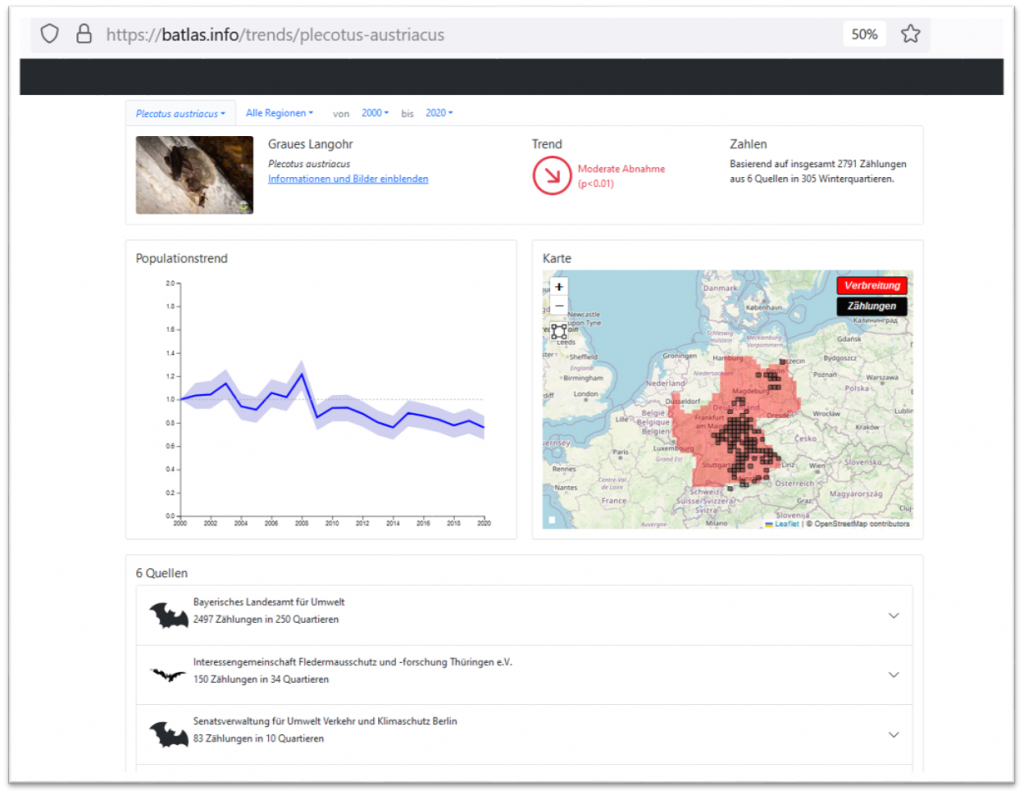As part of the project “Endangered Data of Endangered Species” of the University of Greifswald, which has been funded by the BfN with funds from the BMUV since 2020, the so-called “BATLAS” was developed. BATLAS is a kind of nationwide online atlas, which, in addition to the distribution, shows population trends of different bat species.
Project goal
The aim of the project is to transfer as much data as possible from hibernacula and maternity roost counts of bat conservationists into the BATLAS database
and to determine realistic and up-to-date population trends for bat species. On the website of BATLAS are the research questions that are to be answered with the project “Endangered Data of Endangered Species”. A special focus is on the
temporal development of bat populations in order to be able to assess the endangered status more accurately and nationwide.
The website of the BATLAS project can be accessed via the following link:
https://batlas.info/
Evaluation
For the evaluation, a so-called TRIM analysis is used, a standard method that was specially developed for annual counting data and the creation of of population trends. In addition, TRIM is able to cope with difficulties such as incorrect data or over- and under-estimating. The more data sets are included in this project, the more realistically the population trend develops with regard to a nationwide scale.
Participation
Participation in the project is uncomplicated and possible for all bat conservationists in Germany. The contact address is:
info@batlas.info
Participation is coordinated by the University of Greifswald and user accounts are assigned for organisational reasons. Registered users can access a login area where they can enter their bat site data and analyse it independently with a TRIM analysis tool. The population trends of your own data can then be downloaded and used for your own purposes.
Originator and anonymity of the data
Under “Sources” you will find a list of all institutions and bat conservationists who have entered the data on a particular bat species into the BATLAS database and who have agreed to be named. The exact location of the quarters is excluded, the assignment takes place in 20x20km quadrants. For this reason, it is also not necessary to provide precise coordinates.
Challenges
Not all bat species can be counted well in roosts. One challenge, for example, is the data analysis of migratory or above-ground wintering species, such as the noctule, the lesser noctule, the parti-colored bat and the Nathusius pipistrelle. For these species, the correct analysis method is still being worked on. Trends of these types should also be available in the future, as they are currently in focus, especially against the background of the progressive expansion of wind energy. Some species wintering underground also pose challenges for data analyses. For example, the Bechstein’s bat is underrepresented in the hibernacula counts due to its hiding behaviour, which leads to uncertainties in the trends. Such uncertainties also occur in the barbastelle, as the species only visits the underground sites when the outside temperatures are particularly cold and the counting result is therefore temperature-dependent. For these species, it is essential to use other types of data, such as maternity counts and marking data. The University of Greifswald and its cooperation partners are also working on this.
Conclusion
The BATLAS project presents up-to-date and Germany-wide population trends of native bat species. It is a highly interesting and much-needed tool that facilitates the nationwide monitoring of bat species and enables a faster intervention in the event of population declines. The structure of the website is clear, user-friendly and provides a lot of information about the project and the individual bat species. Additionally, the indication of the authors of the data demonstrates a necessary form of appreciation for the efforts of the bat conservationist, but also keeps an eye on the anonymity of the roosts. The BATLAS website, as well as the project, are constantly evolving, ideas and suggestions for improvement are welcome.

with a moderate decrease in the total population based on 2791 counts from
six sources in 305 districts. At the top right, the representation of the distribution area of the Grey Long-eared Grey in Germany in red with the data points of the censuses marked in grey (as of 14.08.2023).
